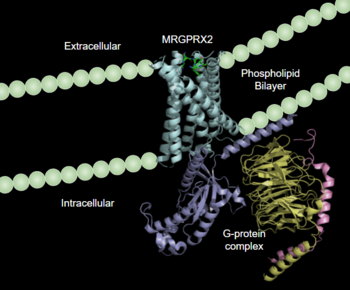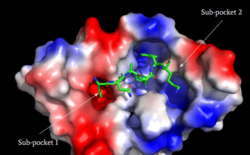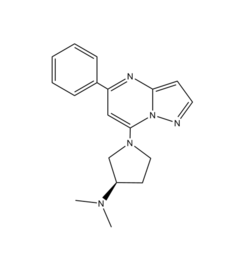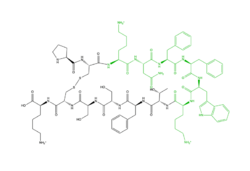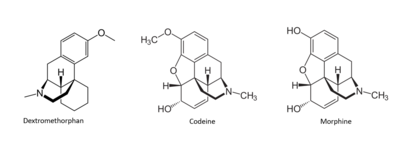Sandbox Reserved 1723
From Proteopedia
(Difference between revisions)
| Line 2: | Line 2: | ||
== '''''Human Itch GPCR''''' == | == '''''Human Itch GPCR''''' == | ||
| - | <StructureSection load='' size='350' frame='true' side='right' caption='Structure of MRGPRX2 with transmembrane helices shown in blue, Gαq shown in purple, Gβ1 shown in yellow, and Gγ2 shown in pink (PDB entry [https://www.rcsb.org/structure/7S8L 7S8L]' scene='90/904327/Overviewfrontpage/1'> | + | <StructureSection load='' size='350' frame='true' side='right' caption='Structure of MRGPRX2 with transmembrane helices shown in blue, Gαq shown in purple, Gβ1 shown in yellow, and Gγ2 shown in pink (PDB entry [https://www.rcsb.org/structure/7S8L 7S8L])' scene='90/904327/Overviewfrontpage/1'> |
| + | |||
| + | [[Image:MP.PNG|350px|right|thumb|'''Figure 1''':MRGPRX2 in the cellular membrane. <ref name="Cao"/>]] | ||
== G-Protein Coupled Receptors == | == G-Protein Coupled Receptors == | ||
| Line 13: | Line 15: | ||
=== MRGPRs === | === MRGPRs === | ||
| - | The human itch GPCR, or Mas-related G-protein coupled receptor (MRGPR), is a Class A GPCR found in human sensory neurons and is responsible for the sensation of “itching” caused by skin irritation and diseases, insect bites, and hypersensitivity to certain drugs. MRGPR's are broken into 4 groups consisting of MRGPRX1, MRGPRX2, MRGPRX3, and MRGPRX4. MRGPRX4 is responsible for cholestatic itching, an intense itching felt during pregnancy on the soles of the feet and palms of hands. Meanwhile, MRGPRX2 regulates [https://en.wikipedia.org/wiki/Degranulation degranulation] and [https://en.wikipedia.org/wiki/Hypersensitivity#:~:text=Hypersensitivity%20(also%20called%20hypersensitivity%20reaction,may%20be%20damaging%20and%20uncomfortable. hypersensitivity] itch reactions <ref name="Cao">Cao, Can, et al. "Structure, function and pharmacology of human itch GPCRs." Nature, Nature Publishing Group, 17 November 2021, https://www.nature.com/articles/s41586-021-04126-6</ref>. These two, chiefly MRGPRX2, are often targets for drugs that result in mast cell degranulation and hypersensitivity side effects. In comparison to other Class A GPCRs, MRGPRX2 binds to an even wider range of ligands, including agonists such as | + | The human itch GPCR, or Mas-related G-protein coupled receptor (MRGPR), is a Class A GPCR found in human sensory neurons and is responsible for the sensation of “itching” caused by skin irritation and diseases, insect bites, and hypersensitivity to certain drugs. MRGPR's are broken into 4 groups consisting of MRGPRX1, MRGPRX2, MRGPRX3, and MRGPRX4. MRGPRX4 is responsible for cholestatic itching, an intense itching felt during pregnancy on the soles of the feet and palms of hands. Meanwhile, MRGPRX2 regulates [https://en.wikipedia.org/wiki/Degranulation degranulation] and [https://en.wikipedia.org/wiki/Hypersensitivity#:~:text=Hypersensitivity%20(also%20called%20hypersensitivity%20reaction,may%20be%20damaging%20and%20uncomfortable. hypersensitivity] itch reactions <ref name="Cao">Cao, Can, et al. "Structure, function and pharmacology of human itch GPCRs." Nature, Nature Publishing Group, 17 November 2021, https://www.nature.com/articles/s41586-021-04126-6</ref>. These two, chiefly MRGPRX2, are often targets for drugs that result in mast cell degranulation and hypersensitivity side effects, such as swelling and itching. In comparison to other Class A GPCRs, MRGPRX2 binds to an even wider range of ligands, including agonists such as cationic small molecules and peptide ligands. |
| - | [[Image:Electro.PNG|250px|right|thumb|'''Figure 1''': Binding pocket of MRGPRX2 with Cortistatin. Two different binding pockets are present in MRGPRX2 and cortistatin interacts with both of them. <ref name="Cao"/>]] | + | [[Image:Electro.PNG|250px|right|thumb|'''Figure 1''': Binding pocket of MRGPRX2 with Cortistatin. Two different binding pockets are present in MRGPRX2 and cortistatin interacts with both of them. <ref name="Cao"/>]] This is a result of normal conserved motifs in class A being different in MRGPRX2. |
| Line 33: | Line 35: | ||
===== ''DRY Motif'' ===== | ===== ''DRY Motif'' ===== | ||
| - | The DRY motif is a proton microswitch that is located near the G-protein binding site C-terminal on TM3 <ref name="Schonegge"/>. It acts as an ion lock when the GPCR is not being activated, preventing unnecessary activation of the G-proteins <ref name="Zhou"/>. This motif is conserved in typical Class A GPCRS however, in MRGPRX2 it is only partially conserved. The arginine is conserved, while the aspartate is replaced by a glutamate and the tyrosine is replaced by a cysteine <ref name="Yang"/> <ref name="Sandoval">Sandoval, A., et al. "The Molecular Switching Mechanism at the Conserved D(E)RY Motif in Class-A GPCRs." Biophysical journal, 111(1), 79-89. https://doi.org/10.1016/j.bpj.2016.06.004 </ref>. | + | The DRY motif is a proton microswitch that is located near the G-protein binding site C-terminal on TM3 <ref name="Schonegge"/>. It acts as an ion lock when the GPCR is not being activated, preventing unnecessary activation of the G-proteins <ref name="Zhou"/>. This motif is conserved in typical Class A GPCRS however, in MRGPRX2 it is only partially conserved. The arginine is conserved, while the aspartate is replaced by a glutamate and the tyrosine is replaced by a cysteine <ref name="Yang"/> <ref name="Sandoval">Sandoval, A., et al. "The Molecular Switching Mechanism at the Conserved D(E)RY Motif in Class-A GPCRs." Biophysical journal, 111(1), 79-89. https://doi.org/10.1016/j.bpj.2016.06.004 </ref>. The replacement of tyrosine for cysteine results in the helices coming closer together, creating a shallower binding pocket.<ref name="Zhou"/> |
===== ''Sodium Binding'' ===== | ===== ''Sodium Binding'' ===== | ||
| - | The sodium site motif facilitates the conformational change of GPCR upon activation <ref name="Katritch">PMID: 24767681</ref> | + | The sodium site motif facilitates the conformational change of GPCR upon activation.<ref name="Katritch">PMID: 24767681</ref> A sodium molecule sits in the middle of the TM7 helices where it is stabilized by conserved residues aspartate (TM2), serine (TM2), and three water molecules. The sodium is able to make a salt bridge with the aspartate at this position. The sodium acts similar to a ball joint in which it allows for the TM helices be spread apart and induce larger conformational change upon binding. In MRGPRX2 this motif is only partially conserved. The aspartate (TM2) is conserved while the serine is replaced by a glycine.<ref name="Yang"/> This creates a less favorable environment for the stabilization of sodium. Currently, in crystallization structures no sodium has been seen at this site. Thus making it inconclusive on whether it plays a role in the conformational change to activate G-proteins upon binding to the receptor.<ref name="Yang"/> |
| + | |||
==== Agonists ==== | ==== Agonists ==== | ||
| Line 46: | Line 49: | ||
===== Peptide ===== | ===== Peptide ===== | ||
| - | <scene name='90/904328/Overview_x2_c_pt_2/1'>Cortistatin-14</scene> is one of the peptide ligands that binds to MRGPRX2. Cortistatin-14 interacts with the binding pocket through an <scene name='90/904328/Zic14_pt_2/1'>electrostatic</scene> interaction in sub-pocket 1 between Lys-3 on the peptide and Glu-164 and Asp-184 on MRGPRX2 <ref name="Cao"/>. Additionally, there are hydrophobic interactions in sub-pocket 2 between the peptide and the binding pocket due to the large hydrophobic amino acids on Cortistatin-14. [[Image: Peptide.PNG|250px|left|thumb|'''Figure | + | <scene name='90/904328/Overview_x2_c_pt_2/1'>Cortistatin-14</scene> is one of the peptide ligands that binds to MRGPRX2. Cortistatin-14 interacts with the binding pocket through an <scene name='90/904328/Zic14_pt_2/1'>electrostatic</scene> interaction in sub-pocket 1 between Lys-3 on the peptide and Glu-164 and Asp-184 on MRGPRX2 <ref name="Cao"/>. Additionally, there are hydrophobic interactions in sub-pocket 2 between the peptide and the binding pocket due to the large hydrophobic amino acids on Cortistatin-14. [[Image: Peptide.PNG|250px|left|thumb|'''Figure 3''': Structure of Cortistatin-14 with resolved amino acids highlighted in green.<ref name="Yang">Yang, Fan, et al. "Structure, function and pharmacology of human itch receptor complexes." Nature, Nature Publishing Group, 17 November 2021, https://www.nature.com/articles/s41586-021-04077-y</ref>]] |
| Line 59: | Line 62: | ||
[[Image: Drugs.PNG|400px|right|thumb|'''Figure 4''': Structures of Dextromethorphan, Morphine, and Codeine.<ref name="Cao"/>]] | [[Image: Drugs.PNG|400px|right|thumb|'''Figure 4''': Structures of Dextromethorphan, Morphine, and Codeine.<ref name="Cao"/>]] | ||
| - | Many drugs activate MRGPRX2 as a side effect that causes the sensation of itchiness <ref name="Cao"/>. Among these drugs are morphine, codeine, and dextromethorphan.These drugs | + | Many drugs activate MRGPRX2 as a side effect that causes the sensation of itchiness <ref name="Cao"/>. Among these drugs are morphine, codeine, and dextromethorphan. These drugs contain similar chemical features that are also found in (R)- ZINC-3573, introducing the idea of a similar binding mechanism <ref name="Babina"> Babina, M., et al. "MRGPRX2 Is the Codeine Receptor of Human Skin Mast Cells: Desensitization through β-Arrestin and Lack of Correlation with the FcεRI Pathway." Journal of Investigative Dermatology, 141(6), 1286-1296. https://doi.org/10.1016/j.jid.2020.09.017</ref>. |
Due to mutations in key structural features of typical Class A GPCRS, MRGPRX2, it is able to bind to a variety of substrates that then mediate the signaling pathway for the sensation of itching. | Due to mutations in key structural features of typical Class A GPCRS, MRGPRX2, it is able to bind to a variety of substrates that then mediate the signaling pathway for the sensation of itching. | ||
Revision as of 18:41, 14 April 2022
| This Sandbox is Reserved from February 28 through September 1, 2022 for use in the course CH462 Biochemistry II taught by R. Jeremy Johnson at the Butler University, Indianapolis, USA. This reservation includes Sandbox Reserved 1700 through Sandbox Reserved 1729. |
To get started:
More help: Help:Editing |
Human Itch GPCR
| |||||||||||
References
- ↑ 1.0 1.1 1.2 1.3 1.4 1.5 1.6 Cao, Can, et al. "Structure, function and pharmacology of human itch GPCRs." Nature, Nature Publishing Group, 17 November 2021, https://www.nature.com/articles/s41586-021-04126-6
- ↑ Thal, David M., et al. "Structural insights into G-protein-coupled receptor allostery." Nature, Nature Publishing Group, 04 July 2018, https://www.nature.com/articles/s41586-018-0259-z
- ↑ 3.0 3.1 Zhang D, Zhao Q, Wu B. Structural Studies of G Protein-Coupled Receptors. Mol Cells. 2015 Oct;38(10):836-42. doi: 10.14348/molcells.2015.0263. Epub 2015, Oct 15. PMID:26467290 doi:http://dx.doi.org/10.14348/molcells.2015.0263
- ↑ 4.0 4.1 4.2 Zhou Q, Yang D, Wu M, Guo Y, Guo W, Zhong L, Cai X, Dai A, Jang W, Shakhnovich EI, Liu ZJ, Stevens RC, Lambert NA, Babu MM, Wang MW, Zhao S. Common activation mechanism of class A GPCRs. Elife. 2019 Dec 19;8. pii: 50279. doi: 10.7554/eLife.50279. PMID:31855179 doi:http://dx.doi.org/10.7554/eLife.50279
- ↑ 5.0 5.1 5.2 5.3 5.4 5.5 5.6 Yang, Fan, et al. "Structure, function and pharmacology of human itch receptor complexes." Nature, Nature Publishing Group, 17 November 2021, https://www.nature.com/articles/s41586-021-04077-y
- ↑ 6.0 6.1 Schonegge, Anne-Marie, et al. "Evolutionary action and structural basis of the allosteric switch controlling β2AR functional selectivity." Nature, Nature Publishing Group, 18 December 2017, https://www.nature.com/articles/s41467-017-02257-x
- ↑ Sandoval, A., et al. "The Molecular Switching Mechanism at the Conserved D(E)RY Motif in Class-A GPCRs." Biophysical journal, 111(1), 79-89. https://doi.org/10.1016/j.bpj.2016.06.004
- ↑ Katritch V, Fenalti G, Abola EE, Roth BL, Cherezov V, Stevens RC. Allosteric sodium in class A GPCR signaling. Trends Biochem Sci. 2014 May;39(5):233-44. doi: 10.1016/j.tibs.2014.03.002. Epub , 2014 Apr 21. PMID:24767681 doi:http://dx.doi.org/10.1016/j.tibs.2014.03.002
- ↑ Babina, M., et al. "MRGPRX2 Is the Codeine Receptor of Human Skin Mast Cells: Desensitization through β-Arrestin and Lack of Correlation with the FcεRI Pathway." Journal of Investigative Dermatology, 141(6), 1286-1296. https://doi.org/10.1016/j.jid.2020.09.017
